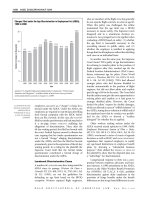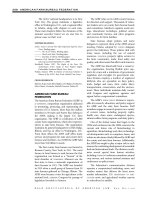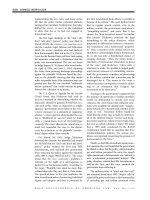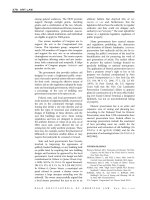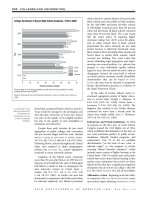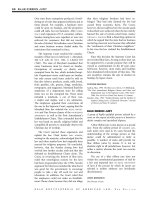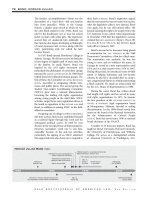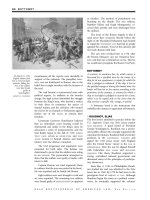Gale Encyclopedia Of American Law 3Rd Edition Volume 3 P4 pptx
Bạn đang xem bản rút gọn của tài liệu. Xem và tải ngay bản đầy đủ của tài liệu tại đây (204.83 KB, 10 trang )
also serves as a certificate of title to the goods,
which is ordinarily in the seller’s name.
Upon shipment, the seller draws a draft
against the buyer-drawee, who is required to
pay the draft. The seller’s bank is named as the
payee. The seller endorses the bill of lading to
the payee and attaches the bill to the draft. The
seller can either
NEGOTIATE these instruments to
the payee at a discount or use them as security
for a loan. Subsequently, the papers are
endorsed by the seller’s bank and delivered to
a correspondent bank in the community where
the buyer is located. The correspondent bank
seeks payment of the draft from the buyer and
when payment is made, the bank transfers
ownership of the goods from seller to buyer by
endorsing the bill of lading to the buyer. The
buyer can then obtain the goods from the
carrier upon presentation of the bill of lading,
which demonstrates his or her title to the
shipped goods.
A check is a specific kind of draft, which is
drawn on a bank and payable on demand to a
particular individual or to the bearer, in which
case it can be written payable to “cash.”
An individual who opens a checking account
is engaged in a contractual relationship with a
bank. The individual agrees to deposit money
therein, whereas the bank agrees that it is
indebted to the depositor for the amount in
the account, in addition to promising to honor
checks written for payment against the account
when there are sufficient funds on hand to do so.
A
CERTIFICATE OF DEPOSIT, frequently referred
to as a CD, is a written recognition by a bank of
the acquisition of a sum of money from a
depositor for a designated period of time at a
specified interest rate, coupled with a promise
of repayment. The bank is both the maker and
the drawee, and the individual making the
deposit is the payee.
Ordinarily, certificates of deposit come in
specific denominations that vary according to
the length of the term that the bank will hold
the funds and are available only for large sums
of money. They are used mainly by co rpora-
tions and individuals as savings devices since
they generally bear higher interest rates than
ordinary savings accounts. They must, however,
be left on deposit for the designated time
period. Ordinarily, a CD can be cashed in prior
to the date of maturity, but some interest will be
forfeited. Depending upon the provisions of the
CD, however, a bank may have the
LEGAL RIGHT
to refuse to close an account before the
expiration of the designated date of maturity.
Negotiability
There are basic requirements for the negotiabil-
ity of commercial paper. The instrument must
be in writing and signed by either its maker or
its drawer. In addition, it must be either an
unconditional promise, as in the case of a
promissory note, or an order to pay a specific
amount of money, such as a draft. It must be
payable either on demand or at a fixed time to
order or to bearer.
The requirement that the instrument must
be in writing can be met in various ways. The
paper can be printed, typed, engraved, or
written in longhand, either in ink, pencil,
or both. Ordinarily, specimens of commercial
paper can be obtained from banks or stationery
stores.
Similarly, there are a number of ways to
comply with the signature requirement. The
ILLUSTRATION BY GGS
CREATIVE RESOURCES.
REPRODUCED BY
PERMISSION OF GALE,
A PART OF CENGAGE
LEARNING.
Commercial Paper Outstanding, 2004 to 2007
663.9
142.4
730.7
167.1
816.7
162.7
589.5
129.9
0
200
400
600
800
1,000
1,200
2004 2005 2006 2007
Year
Billions of dollars
a
Public utilities and firms engaged primarily in activities
involving communications, construction, manufacturing,
mining, wholesale and retail trade, transportation, and
services.
b
Institutions engaged primarily in commercial, savings, and
mortgage banking; sales, personal, and mortgage financing;
factoring, finance leasing, and other business lending;
insurance underwriting; and other investment activities.
SOURCE: The Federal Reserve Board, Statistical
Supplement to the Federal Reserve Bulletin,
December 2008.
Nonfinancial companies
a
Financial companies
b
GALE ENCYCLOPEDIA OF AMERICAN LAW, 3RD E DITION
18 COMMERCIAL PAPER
signature may legally be either handwritten,
typed, printed, or stamped by a machine.
Individuals who are unable to write their names
can sign with a simple mark, such as an X. Also
permissible are initials, a symbol, a business or
TRADE NAME, or an assumed name. The pledge or
order for payment must be unconditional to
insure certainty that the instrument will be paid,
since it is used in place of money and as a means
of obtaining credit.
When the paper includes an unconditional
promise or order, supplementary facts can be
mentioned that will not defeat its negotiability.
For example, the paper can indicate the
transaction was secured by a mortgage. It might
mention a specific account or fund out of which
payment is expected, although not required.
Ordinarily, such a collateral statement is made
for purposes of accounting and does not create
a conditional promise or order to pay. Payment
can, however, be limited to the total assets
of a partnership, unincorporated association,
or trust.
A promise to pay is conditional when it
indicates that it is either subject to or governed
by another agreement. When payment is
conditional, negotiability is terminated and the
instrument is not commercial paper. The holder
of the paper cannot rely upon the face of the
document to establish and fix his or her right to
payment. A paper does not qualify for treatment
as a negotiable instrument if payment of it is to
be made exclusively from a particular fund,
unless such instrument is issued by a govern-
ment or division thereof.
In dealing with a promissory note, practi-
cally any terms that state a definite promise will
suffice to make the instrument legally enforce-
able. The phrase “I promise to pay” clearly
demonstrates an unconditional pledge of pay-
ment; whereas an IOU is not deemed definite
enough to warrant payment and, therefore, is
not a negotiable instrument. There must be an
order to pay in a check or a draft. A mere
request, as in “I wish you would pay,” is
insufficient. Language used for courtesy, such as
“please pay,” does not, however, defeat the
order. Suitable language to instruct payment
would be “pay to the order of” followed by the
name of the payee.
The holder of the negotiable instrument
must be able to ascertain the precise value of the
paper by looking at its face. In certain instances,
it might be necessary to compute interest, as
in the case of a promissory note that bears a
certain annual rate. A provision for interest does
not impair the determination of the actual sum.
In addition, certainty regarding the amount is
not altered by the fact that the interest rate can
differ before or after default or before or after a
particular date.
The amount payable remains a fixed sum
even in the event that it is paid in installments
or reduced by agreement of payment prior to a
set time or increased following the date of
payment. In addition, the certainty of t he sum is
not affected by a provision for collection of
expenses and lawyer’s fees. The sum must be
payable in money, which is a medium of
exchange adopted by governments; otherwise,
the document is not considered commercial
paper.
An instrument must be payable either on
demand or at a set time in order to have
negotiability. Papers that are payable on demand
are payable upon presentation, such as checks.
When a note or a draft is payable on, or
prior to, a fixed date or for a set period
thereafter, it is considered to be negotiable at a
definite time. When an instrument is payable on
or before a certain date, payment is required no
later than the date indicated, although it can be
made prior to that date. Similarly, a paper made
payable at an established time after sight is
payable at a definite time. After sight means
that upon presentation of the instrument to the
maker by the holder, payment will occur after
the expiration of the time designated on the
note. The payee of a note due one week after
sight must be paid by the maker within a week
of the date it is presented for payment. It need
not be paid immediately upon presentation,
since the terms of the note do not make it a
demand instrument.
If the time provided for payment of an
instrument is definite except for the presence of
an
ACCELERATION CLAUSE, the time of payment of
the instrument is still considered definite. That
is, a note can provide that the time for payment
will be accelerated if a certain event takes place
or at the option of one of the part ies to the
agreement without destroying its negotiability.
Also acceptable are extensions of the payment
period, which can be made at the choice of the
holder, maker, or acceptor, or immediately
when a particular act occurs.
GALE ENCYCLOPEDIA OF AMERICAN LAW, 3RD E DITION
COMMERCIAL PAPER 19
An instrument retains its negotiable quality
even if it is updated, antedated, or postdated. An
undated instrument takes effect immediately
upon delivery to the payee . An antedated paper
is given a date that has passed, and a postdated
instrument is given a future date . In the event
that an instrument is either antedated or
postdated, the determination of the date on
which it becomes legally operative is contingent
upon the date that appears on its face and upon
whether it is payable on demand or on a certain
date. A postdated check cannot be cashed prior
to the date appearing on its face, in spite of
the fact that a check is ordinarily payable on
demand. An instrument is not negotiable if it is
payable upon an occurrence of indefinite
timing, even when the event is certain to
happen, such as death.
The requirement that an instrument be
made payable either to order or to bearer is met
when the paper is made available to the bearer
or to an individual spe cifically designated or to
the order of that person, as in “X, or his order.”
An estate, trust, corporation, partnership, or
unincorporated association may be designated
as a payee of a commercial paper.
An instrument can be made payable to two
or more people, either together or in the
alternative. If the paper is made out to two
parties together, as in “to X and Y,” then both
payees must endorse it before payment will be
made. An instrument made out in the alterna-
tive, however, as in “To X or Y,” requires
endorsement by only one payee in order to be
paid.
Checks and drafts are ordinarily written on
printed forms, made payable both to order and
bearer. An empty space is left between the
words “pay to the order of” and “or bearer.”
When the name of the payee is inserted by the
drawer, the paper is regarded as an order
instrument in spite of the fact that the phrase
“or bearer” is not deleted. In such instances, the
presumption is that the drawer merely neglected
to eliminate this language. An instrument is
bearer paper, however, when it is made payable
to a specific payee and the words “or bearer” are
either typed or handwritten on the document as
additions to it.
Bearer paper is made payable either to the
holder, a speci fic individual, the bearer, or to
cash. It is common for such an instrument to
read “pay to the order of bearer.” This occurs in
the case where a printed form is used and the
term bearer is written in following “pay to
the order of.” The word bearer serves to make
the instrument bearer paper in such an instance.
Bearer instruments are tantamount to cash
because they are freely transferable from one
person to another without requiring an en-
dorsement. They are thereby not as secure as
order instruments since if they are stolen, their
terms permit payment to be made to whoever
possesses them at the time they are presented
for payment. Many banks require customers to
endorse bearer paper prior to payment as a
safety measure. This step provides both the
drawer and the bank with the name of the
individual who is given payment.
Endorsements
An endorsement is the process of signing the
back of a paper, thereby imparting the rights
that the signer had in the paper to another
person. The number of times an instrument
may be endorsed is unlimited. There is no
requirement that the word “order” be embodied
in the endorsement. Four principal kinds of
endorsements exist: special, blank, restrictive,
and qualified.
An endorsement that clearly indicates the
individual to whom the instrument is payable is
a special endorsement.
A paper containing a
BLANK ENDORSEMENT is
one that has the signature of the payee but no
specific endorsee is designated. A check that is
made payable to the order of X is endorsed in
the blank when X signs it. Once endorsed, it
becomes bearer paper and is negotiable by
anyone who physically holds it. A blank
endorsement is changed into a special endorse-
ment if certain words are written above the
endorsee’s signature, such as “pay to the order
of Y.”
A qualified endorsement is one wherein
liability is disclaimed by the endorser through
inclusion of a phrase preceding his or her
signature. Ordinarily, an unqualified endorser ’s
liability may be either secondary, whereby the
endorser is bound to pay if the individual
expected to pay defaults and certain conditions
are met or by warranty, by which the endorser
incurs liability upon alteration of the instru-
ment. To disclaim secondary liability, the
endorser can include the words “without
GALE ENCYCLOPEDIA OF AMERICAN LAW, 3RD E DITION
20 COMMERCIAL PAPER
recourse,” thereby relieving himself or herself of
any responsibility to pay it.
Attorneys who are the recipients of checks
drawn in settlement of the claims of their clients
commonly sign their clients’ checks with
qualified endorsements. This type of check is
ordinarily made payable to the lawyer and client
jointly. It is generally endorsed by the lawyer
WITHOUT RECOURSE and given to the client. The
attorney then is not liable if the client does not
receive the money promised by the terms of the
check.
A restrictive endorsement is conditional and
attempts to prevent subsequent transfer of the
document. The language of the endorsement
indicates that the instrument is intended for
limited use, such as “for deposit only,” or
specifies that the paper is meant for the benefit
of the endorser or another individual, as in “Pay
X in trust for Y.” The condition imposed by a
restrictive endorsement must be satisfied before
payment can be properly made.
However, an endorsement that tries to
prohibit further transfer of an in strument will
not succeed. If a check says “Pay X only,” it is
still completely negotiable upon its endorse-
ment by X.
Liability of Parties
An individual who signs an instrument is either
primarily or secondarily liable for payment.
Primary liability is extended to the person who
is expected to pay first, and the individual who
is legally responsible to pay upon the failure of
the first party to do so is secondarily liable.
The maker of a prom issory note is primarily
liable, since that person is the individual who
has originally promised to pay. He or she must
meet this obligation when payment becomes
due unless he or she has a valid defense or has
been discharged of the debt.
The drawer of a check or draft is secondarily
liable, since that individual does not make an
unconditional promise to pay the instrument.
He or she expects the bank to pay and promises
to pay the amount of the instrument only upon
notification of dishonor, a refusal by the drawee
to accept the paper when properly presented for
payment. This might occur, for example, if the
bank refuses to pay a check due to insufficient
funds in the drawer’s checking account or
because he or she has notified the drawee to
stop payment.
The drawee of a draft or check has primary
liability to the holder, an individual who has
lawfully acquired possession and is entitled to
payment, upon acceptance of the instrument by
the drawee. A draft is accepted for payment
when the acceptance is indicated by the drawee
on the face of the document. Certification of an
instrument, such as a check, is its acceptance by
a bank guaranteeing that payment will be
forthcoming. A drawee is liable to the drawer
if the drawee refuses to pay a draft or check
that is properly drawn and presented because
such action constitutes a noncompliance of the
drawee’s contractual obligation to the drawer.
Any person who places his or her unquali-
fied endorsement on a commercial paper incurs
secondary liability for its payment. Such liability
occurs when the individual who has the primary
duty to pay defaults on his or her obligation.
A maker or drawer is not relieved from
payment of an instrument endorsed with the
payee’s name when an imposter manages to
have a paper issued to himself or herself by the
maker or drawer; when an individual signing on
the behalf of the maker or drawer plans that the
payee shall have no interest in the paper, for
example, the case of a check being made out to
a fictitious payee; and when the agent or
employee of the maker or drawer designates
the name of a payee with the intent that the
named party will actually have no interest in the
instrument. In the last two instances, the failure
of the employer to use reasonable care in
choosing and supervising employees makes the
employer personally responsible for all losses
that arise from his or her
NEGLIGENCE. Many
employers guard against such risks by taking
out
FIDELITY INSURANCE policies to cover losses
that might occur through employee misconduct.
Secondary Liability
Individuals who are secondarily liable on a
negotiable instrument are not obliged to pay
unless it has been presented for payment and
dishonored. The commercial paper must first
be given to the person who is primarily liable
for payment. In the event that the instrument
clearly notes the date of payment, the instru-
ment must be presented on the date indicated.
If payment is unjustifiably refused by the
individual who has primary liability, the secon-
dary party must be given notice of the dishonor
and the presentation of the instrument for
GALE ENCYCLOPEDIA OF AMERICAN LAW, 3RD E DITION
COMMERCIAL PAPER 21
payment must be made within a reasonable
period of time. What constitutes a REASONABLE
TIME
is contingent upon what type of instrument
is involved. If the paper is a check, the drawer
has primary liability for thirty days following
the date on the check or the day it was given
or sent to the payee, with the later date
prevailing. An endorser is secondarily liable
for seven days following his or her endorse-
ment. When presentation does not occur within
these time periods, either the drawer or the
endorser may escape liability.
Individuals who are secondarily liable must
receive notice of the dishonor of a commercial
paper in order to be held liable for its payment.
Such notice must be given by a bank prior to
midnight on the date following the dishonor.
Notice can be oral or in writing, as long as
the language identifies the paper and indicates
that it has been dishonored. If more than one
person is eligible to obtain payment, only one
of them needs to notify those parties who are
secondarily liable.
Holders
A holder is an individual who is in possession of
an instru ment that is either payable to him or
her as the payee, endorsed to him or her, or
payable to the bearer. Those who obtain
instruments after the payee are holder s if such
instrument is either payable to the bearer or
endorsed properly to their order. The party in
possession is not considered to be the holder in
a case in which a necessary endorsement has
been forged.
According to law, a holder may either be an
ordinary holder or a
HOLDER IN DUE COURSE, who
has preemptive rights to payment. An ordinary
holder becomes a holder in due course upon
taking an instrument subject to the reasonable
belief that it will be paid and that there are no
legal reasons why payment will not occur.
In more technical terms, to be a holder in
due course, the party must take the paper for
value, in
GOOD FAITH, and absent the notice that
it is overdue, has been dishonored, or is subject
to an adverse claim. Such notice of prob lems
affecting the validity of the instrument exists if
the party either is specifically informed about
something or otherwise has reason to believe in
the existence of a problem.
A holder takes a paper for value when the
holder has imparted something of value, such as
property or services, in exchange for the value
of the paper, as evidenced by its terms. In such a
case, the individual becomes the holder for
value.
If a paper is used in satisfaction of or as
security for the repayment of a debt, even
though the debt might not be due when the
paper is taken, the instrument is taken for value.
In addition, value is given when one commer-
cial paper is traded for another.
A person who receives a check or other type
of negotiable instrument as a gift is an ordinary
holder as opposed to a holder in due course,
since no consideration that is bargained-for
value has been exchanged by the parties.
A holder in due course has greater legal rights
concerning protection for enforcement of the
provisions for payment of a negotiable instru-
ment than does an ordinary holder.
For an individual to be a holder in due
course, the negotiable instrument must be taken
in good faith that it represents a valuable legal
right. There must be honesty in the transaction,
but the determination of whether good faith is
present is totally subjective.
Frequently, a due date is clearly specified on
the face of the document. A holder is presumed
to have knowledge of the terms appearing on
the paper. If an individual is presented with a
note on May 15 that is payable on May 1, he or
she is regarded as having knowledge that it is
overdue. A person is legally considered to have
knowledge that a demand instrument is overdue
if he or she accepts it after being informed that a
demand for payment has previously been made
and refused or if a reasonable period of time has
elapsed since its issuance. Ordinarily, 30 days
after the date on which a check was issued is a
reasonable time period within which its presen-
tation to a bank for payment should occur. An
individual who accepts a check that is more
than 30 days old is assumed to be doing so with
the knowledge that it is overdue.
An instrument that has been dishonored
ordinarily has that fact indicated on its face. For
example, a check might be stamped “insufficient
funds,”“account closed,” or “payment stopped.”
An individual who accepts such a document
possessing knowledge of its dishonor cannot be
a holder in due course. A person cannot be a
holder in due course if he or she takes an
instrument subject to his or her knowledge that
a claim exists against it, such as when it has been
stolen or transferred as a result of
FRAUD.
GALE ENCYCLOPEDIA OF AMERICAN LAW, 3RD E DITION
22 COMMERCIAL PAPER
Defenses
A holder of a negotiable instrument who has
been refused payment when payment was due
has a
CAUSE OF ACTION against the party or parties
liable for payment. Ordinarily, when an indi-
vidual is sued on a negotiable paper, he or she
will try to defend his or her right to refuse
payment. Certain defenses, known as real defenses,
are valid against ordinary holders as well as
holders in due course, whereas personal defenses
are only valid against ordinary holders.
Normally, any defense that can be asserted
in an action concerning a contract may also be
used in an action brought to enforce payment of
a negotiable instrument. The legal incapacity
of the maker, drawer, or endorser, a signature
effected by duress, illegality, or fraud, and
alteration of the instrument qualify as real
defenses.
One of the most prevalent legal incapacity
defenses asserted is infancy. The law affords
protection to infants by permitting them to
evade their contractual obligations, even when,
in some instances, they have reaped the benefits.
A holder is usually excluded from receiving
paymentonanotefromaminor.
Another incapacity defense is legal insanity
or incompetency. A party who has been legally
declared insane or incompetent is not liable for
any contractual obligations entered during that
time so that if such a person signs or endorses a
negotiable instrument, the transact ion is nulli-
fied. Intoxication is not a valid defense to
dishonor of a commercial paper.
Duress may be used as a defense in the event
that the individual against whom a suit is
brought can prove that he or she was subject to
extreme pressur e caused by another at the time
of the execution of the paper. If the
DEFENDANT
signed the instrument subject to a threat of
immediate physical violence or death, he or she
is not legally bound to honor its terms since he
or she had not freely entered into the transac-
tion. Certain types of duress, such as a threat to
report a wrongdoing to the police or to bring a
civil lawsuit, are not valid against a holder in
due course, although they can be used as valid
personal defenses against an ordinary holder.
Certain jurisdictions deem a paper that has
been negotiated to pay a usurious loan or
gambling debt null and void. An individual can
legally avoid payment to the holder in due
course of such an instrument based on the
illegal nature of the debt it was meant to pay.
Two basic types of fraud exist: fraud in the
essence and fraud in the inducement. Fraud in the
essence occurs when an individual is inten-
tionally lied to about the nature of the
instrument or its terms. It is a defense that is
valid again st both an ordinary holder and a
holder in due course. Fraud in the inducement
takes place when the party signing the paper is
cognizant of its nature and term s but is misled
into believing that the reasons for its creation
have been satisfied when in actuality they have
not. For example, an individual might be
induced to issue a check for a certain amount
to a mechanic who claims to have repaired a
car. If the individual subsequently discovers that
the car was not repaired, fraud may be used as a
personal defense against the mechanic who has
not performed his or her part of the contract to
repair the car. Fra ud in the inducement is only
valid against an ordinary holder, not a holder in
due course.
A material alteration is an addition or
deletion of the language of an instrument,
which changes the obligations of any party to it.
A defendant may avoid liabili ty for payment of a
commercial paper if its terms have been
materially altered. Examples of such alterations
are a change in the date of payment or amount
to be paid. When an individual’s own negli-
gence is a contributing factor to a material
alteration, that negligence ma y not be asserted
by him or her as a defense against someone who
pays the instrument in good faith or against a
holder in due course.
An alteration made by a holder that is both
material and
FRAUDULENT can be used as a
defense against enforcing the payment of the
document by all those people whose agreements
were changed. If these two conditions of
materiality and fraud are not met, the instru-
ment is ordinarily enforceable according to the
way it was initially written, and none of those
involved can use the alteration as a defense
against payment.
When a holder in due course takes a paper
following its fraudulent alteration by the previ-
ous holder, he or she is entitled to receive
payment according to the original terms of the
instrument prior to its alteration. None of
the parties responsible for payment can use the
alteration as a defense against a holder in due
GALE ENCYCLOPEDIA OF AMERICAN LAW, 3RD E DITION
COMMERCIAL PAPER 23
course, but it may be used against an ordinary
holder.
Discharge from Liability
The most common way to be discharged from
liability on a commercial paper is through
payment. The intentional
CANCELLATION OF AN
INSTRUMENT
by the holder by either marking the
instrument paid or by destroying it discharges
all liability.
The holder may also discharge an individual
from liability for payment through renunciation.
This can be accomplished when a document is
signed and delivered by the holder or when a
paper is relinquished to the party who is being
discharged. A stop-payment order put on a
check by its drawer has the effect of discharging
the bank from liability for refusing to honor the
check when presented for payment. It cannot,
however, discharge the drawer from liability in
cases where the drawer was contractually or
otherwise obligated to pay the payee.
Credit Freeze of 2008
In 2008 the collapse of the global financial-
services firm Lehman Brothers and subsequent
government bailout of American International
Group, Inc. (AIG), one of the world’s la rgest
insurers, prompted a credit freeze. Investors
became increasingly reluctant to buy commer-
cial paper, thereby terminating a major source
of funding for large corporations. This freeze
resulted in the Federal Reserve’s creation of the
Commercial Paper Funding Facility (CPFF),
which purchases commercial paper from issuers
and, acting through special purpose vehicles,
provides liquidity to its customers. The goal of
the CPFF is thus to unfreeze the credit markets,
prompting investors to lend again in the com-
mercial paper market.
FURTHER READINGS
Bamford, Janet. 1992. The Consumer Reports Money Book.
New York: Consumers Reports.
Blue, Ron. 1993. Master Your Money: A Step-by-Step Plan for
Financial Freedom. Nashville, TN: Thomas Nelson.
Liuzzo, Anthony. 2010. Essentials of Business Law. 7th ed.
New York, NY: McGraw-Hill Higher Education.
Milling, Bryan E. 1993. How to Get a Loan or Line of Credit
for Your Business: A Banker Shows You Exactly What You
Need to Do to Get a Loan. Naperville, TN: Sourcebooks.
Nickles, Steve H. 2010. Payments LAw and Commercial
Paper: Learning and Teaching Materials St. Paul: Minn.:
West.
Weber, Charles M. 1982. Commercial Paper in a Nutshell.
3d ed. West Group.
CROSS REFERENCES
Bonds; Documentary Evidence.
COMMERCIAL SPEECH
See FIRST AMENDMENT; FREEDOM OF SPEECH.
COMMINGLING
Combining things into one body.
The term commingling is most often applied
to funds or assets. When a
FIDUCIARY, a person
entrusted with the management of funds other
than his or her own in trust, mixes trust money
with that of others, the fiduciary is commingling
funds and thereby breaching his or her fiduciary
duty.
A member of a corporation’s board of
directors commingles funds when he or she
mixes personal funds with the funds of the
corporation. An attorney who commingles his
or her money with money belonging to a client
is violating the ethics of the legal profession.
COMMISSION ON CIVIL RIGHTS
The federal COMMISSION ON CIVIL RIGHTS evaluates
CIVIL RIGHTS laws and policies of the U.S.
government, follows legal developments regard-
ing discrimination, in vestigates allegations that
U.S. citizens are being denied their civil rights,
and evaluates equal opportunity programs. It
collects and monitors information on discrimi-
nation or the denial of
EQUAL PROTECTION of the
laws on the basis of race, color,
RELIGION, sex,
age, handicap, or national origin. It also
investigates equality of opportunity in voting,
education, employment, transportatio n, hous-
ing, and the administration of justice.
The commission holds public hearings,
publishes findings and reports, and maintains
a toll-free phone line by which people may
make complaints regarding civil rights. The
commission disseminates the information it
gathers but cannot enforce existing civil rights
laws. It offers its findings and makes recom-
mendations to the presiden t and to Congress.
Many of the commission’s recommendations
have been incorporated into laws, executive
orders, and regulations. The commission also
collects and stores civil rights information
gathered from around the United States.
The Commission on Civil Rights was created
by the Civil Rights Act of 1957, and it was later
GALE ENCYCLOPEDIA OF AMERICAN LAW, 3RD E DITION
24 COMMERCIAL SPEECH
reestablished by the U.S. Commission on Civil
Rights Act of 1983 (42 U.S.C.A. § 1975 et seq.).
It maintains six regional offices and is headed by
eight members, or commissioners, of whom no
more than four shall come from any one political
party. Members serve for three or six years. Four
members of the commission are appointed by
the president, two by the president pro tempore
of the Senate, and two by the Speaker of the
House of Representatives. The president desig-
nates a chairperson and vice chairperson from
among the commission’smembers.
From the beginning, the Commission on
Civil Rights has interjected itself in controversy.
It has investigated activities ranging from dis-
crimination to hate crimes. Because appoint-
ments to the commission are political, its tone
often swings from the right to the left, depend-
ing on who is president. During the 1980s, it
issued opinions that were so conservative some
congressional Democrats wanted to shut it
down. In contrast, during the 1990s, under the
leadership of its outspoken chairwoman, Mary
Frances Berry, it tilted toward the left.
One of the commission’s most controversial
actions was its investigation into the 2000
presidential election in Florida. After a six-month
investigation, the commission issued a report
claiming that Florida’s conduct of this election
was marked by “injustice, ineptitude and
inefficiency.” The report claimed that minority
voters were disenfranchised through unequal
access to voting equipment and overzealous
efforts to purge state voter lists of felons and
other ineligible voters. The commission recom-
mended that the
JUSTICE DEPARTMENT initiate
LITIGATION to correct this discrimination.
The four commissioners who backed the
report were Democrats or otherwise considered
liberal. Two Republican commissioners issued
a dissenting report, stating that the Florida
election problems were hampered by uninten-
tional and unanticipated problems that were
not motivated by racial bias and that did not
disenfranchise minority voters. The
DISSENT
cited a study that low income and literacy rates
were more likely than race to explain the
number of ballots rejected in certain neighbor-
hoods. In addition to the dissenters, Florida’s
Republican governor and
SECRETARY OF STATE
denounced the commi ssion’s findings.
Lost in the controversy over whether the
commission’s finding of bias in the Florida 2000
presidential election was itself biased were some
non-controversial recommendations of the
commission. These included better training for
poll-workers, upgraded voting equipment that
would be consistently used, and better resource
allocation for voting education. Some of the
commission’s recommendations were later
adopted by Florida for the 2002 election cycle.
The fact that appointees to the commission
are political has meant that the appointment
process to the commission itself has become
political at times. For example, in 1993 Repub-
licans refused to confirm a Democratic appoin-
tee for the chair of the commission. In 2002, a
Republican appointee to the commission had to
go to court before he could take his seat on the
commission.
Nevertheless, the commission has remained
in existence for more than 50 years, and has
made valuable contributions to America’scivil
rights debate in that period. Its web site, www.
usccr.gov, gives important information on how
to enforce federal civil rights laws, and different
state civil rights organizations. As long as it
exists, the commission will probably stir up
controversy, but ideally it will continue to
educate and enlighten about civil rights issues.
The commission had a relatively low profile
during most of the 2000s. In 2005 and 2006, the
commission released a series of reports about
such issues as the Justice Department’s record
with regard to enforcement of voting rights and
the funding of civil rights enforcement initiatives.
FURTHER READINGS
Carlson, Peter. 2002. “Uncivil Fights; The Commissioners
Have a Job to Do. But First, They Have to Agree to
Meet.” Washington Post (October 30).
U.S. Commission on Civil Rights. 2005. Funding Federal
Civil Rights Enforcement: The President’s 2006 Request
web-
site home page: (accessed May
13, 2009).
U.S. Commission on Civil Rights. June 2001. Voting
Irregularities In Florida During the 2000 Presidential
Election. Available online at www.usccr.gov/pubs/
vote2000/report/main.htm; website home page: http://
www.usccr.gov (accessed June 15, 2009).
U.S. Government Manual Website. Available online at http://
www.gpoaccess.gov (accessed May 13, 2009).
COMMISSIONER
A person charged with the management or direction
of a board, a court, or a government agency.
A commissioner has the power and respon-
sibility to administer laws or rules that relate to
GALE ENCYCLOPEDIA OF AMERICAN LAW, 3RD E DITION
COMMISSIONER 25
a specific subject matter over which he or she
has authority. Generally, he or she is appointed
specially, as in the case of a commissioner of
court.
COMMISSIONERS ON
UNIFORM LAWS
The United States has a central federal govern-
ment, the authority of which is restricted to
those powers given to it by the Constitution.
Each state has its own system of legislative and
judicial functions that operate in areas not
within the exclusive control of the federal
government.
Attempts have been made to provide an
organized system of uniform legislation
throughout the states. The
COMMISSIONERS ON
UNIFORM LAWS
, properly known as the National
Conference of Commissioners on Uniform
States Laws and also referred to as the Uniform
Law Commissioners, was established in 1890 to
draft uniform and model laws on subjects where
uniformity is desirable. The organization con-
sists of more than 300 lawyers, judges, and law
professors, each selected by the state govern-
ments. The acts approved by the organization
do not become “law” in the states until they are
adopted by legislatures of those states, and the
Commissioners on Uniform Laws work with
the legislatures to promote such enactments.
The organization has been most instrumen-
tal in persuading the states to adopt commercial
laws approved by the commissioners, most
notably the
UNIFORM COMMERCIAL CODE (UCC).
It has also drafted a number of laws relating in
such areas as
CHILD CUSTODY, business organiza-
tions, and consumer law. The commissioners
often work in conjunction with such organ iza-
tions as the
AMERICAN BAR ASSOCIATION and the
American Law Institute when drafting the
uniform and model laws.
The web site of the Commissioners on Uni-
form Laws is located at .
COMMITMENT
Commitment refers to those proceedings directing
the confinement of a mentally ill or incompetent
person for treatment.
Pursuant to statutory and
CASE LAW, due
process protections are afforded to persons who
have been involuntarily committed, including
periodic
JUDICIAL REVIEW. Commitment has often
raised difficult issues of balancing the civil
liberties of the person who is subject to com-
mitment against competing interests, including
the rights of society to be protected from
individuals who might prove dangerou s as a
result of their mental illness or incompetence
and the community’s interest in ensuring that
these individuals receive proper treatment.
Each state has its own detailed statutory
scheme providing for the involuntary commit-
ment of individuals who might be mentally ill
or incompetent. These statutes usually contain
language defining the types of mental illnesses
and conditions covered by the law, as well as
certain conditions that are excluded from
coverage—generally mental retardation, epilepsy,
developmental disabilities, and drug or alcohol
addiction. In addition, most state commitment
statutes set forth specific criteria or standards
that link these conditions to justifications for
involuntary commitment.
Most jurisdictions have at least one criterion
that is based on a person’s posing a danger to
himself or herself, or others. Some states require
that other criteria which are closely related to
dangerousness be met, such as the presence of a
grave disability or an inability to provide for
one’s basic human needs or that some medical
or psychological treatment is essential to the
person’s welfare. Since the 1980s, some states
have moved significantly away from a strict
dangerousness standard for involuntary com-
mitment. In Arizona, for example, a person who
is “persistently or acutely disabled” because of
mental illness may be subject to commitment
(Ariz. Rev. Stat. Ann. § 36-540 (A) [1995]), and
in Delaware, an individual who cannot make
“responsible decisions” about inpatient care
and treatment may be committed (Del. Code
Ann. tit. 16, § 5001 [1995]). An even broader
standard has been enacted in Iowa, where the
law provides that a person may be committed if
he or she is likely to inflict serious emotional
injury on family or others who “lack reasonable
opportunity” to avoid contact with that person
(Iowa Code Ann. § 229.1 [West 1995] ).
In most jurisdictions, commitment req uires
a showing that inpatient hospitalization is the
least restrictive treatment alternative for the
person, in addition to a showing of dangerous-
ness. This requirement is based on the principle,
established by the U.S. Supreme Court, that
GALE ENCYCLOPEDIA OF AMERICAN LAW, 3RD E DITION
26 COMMISSIONERS ON UNIFORM LAWS
even though a government purpose might be
legitimate and substantial, the purpose “cannot
be pursued by means that broadly stifle
fundamental personal liberties when the end
can be more narrowly achieved.” Shelton v.
Tucker, 364 U.S. 479, 81 S. Ct. 247, 5 L. Ed. 2d
231 (1960). As a result, most states, through
either statutes or case law, recognize a patient’s
right to be treated in the least restrictive setting.
Despite the difficult legal issues relating to
the restriction of liberty that results from
involuntary treatment, the U.S. Supreme Court
has considered the constitutionality of civil
commitment on relatively few occasions. In
1975, in perhaps its most significant decision on
the issue, the Court held that a state “cannot
constitutionally confine … a non-dangerous
individual who is capable of surviving safely in
freedom by himself or with the help of willing
and responsible family members or friends.”
O’Connor v. Donaldson, 422 U.S. 563, 95 S. Ct.
2486, 45 L. Ed. 2d 396. The Court further stated
that a “mere finding” of mental illness “cannot
justify a state’s locking a person up against his
will and keeping him indefinitely in simple
custodial confinement.” Although the Court
appeared to establish the right of a nondanger-
ous individual not to be involuntarily commit-
ted, it left unresolved the issue of whether a
mentally ill person has a constitutional right to
treatment.
In a later decision, Zinermon v. Burch, 494
U.S. 113, 110 S. Ct. 975, 108 L. Ed. 2d 100
(1990), the Court further addressed dangerous-
ness as a justification for civil commitment.
It stated that involuntary commitment proce-
dures “guard against the confinement of a person
who, though mentally ill, is harmless and can live
safely outside an institution.” Confinement of
such a person would be unconstitutional, the
Court held.
The involuntary commitment of individuals
who previously have been convicted of a crime
has presented an entirely new set of constitu-
tional considerations. The most significant issue
has concerned whether a prisoner, following
completion of her or his sentence, may be
committed to a psychiatric facility without
receiving the same due process protections
afforded to other individuals who are subjected
to civil commitment.
The high court addressed the issue in Jones v.
United States, 463 U.S. 354, 103 S. Ct. 3043, 77
L. Ed. 2d 694 (1983). In Jones, the
DEFENDANT was
acquitted of a crime by reason of insanity but
was confined to a psychiatric hospital for longer
than his sentence would have been, had he been
convicted. Michael Jones challenged the consti-
tutionality of his commitment. A 5–4 majority of
the U.S. Supreme Court affirmed the commit-
ment. The Court reasoned that punishment of
an insanity acquittee is inappropriate; therefore,
the length of the criminal sentence that would
have been imposed, had the patient been found
sane, was not relevant. Instead, the Court held,
the duration of the commitment should depend
on the patient’s recovery. Thus, if the patient’s
condition warrants further treatment, the com-
mitment could continue, regardless of the length
of the sentence that otherwise would have been
imposed.
The commitment of individuals who have
been convicted of sex-related crimes has sparked
even more intense debate. Courts in many states
have had to address difficult questions involving
so-called sexual predators: Should these indivi-
duals be allowed to re-enter society after they
have served their prison terms? May a state
detain them indefinitely wit hout violating their
constitutional rights?
These questions went before the U.S.
Supreme Court in Kansas v. Hendricks,521
U.S. 346, 117 S. Ct. 2072, 138 L. Ed. 2d 501 (1997).
In that case, the Court reviewed the constitution-
ality of the Kansas Sexually Violent Predator Act
(Kan. Stat. §§ 59-29a01 et seq.), which estab-
lishes procedures for the civil commitment of
persons who, due to a mental abnormality or
Kenneth Donaldson,
respondent in
O’Connor v.
Donaldson, displays
the Supreme Court’s
opinion, which said
that a state cannot
hold a non-dangerous
individual against his
will if the person is
capable of “surviving
safely” on his own or
with the help of
friends or family.
AP IMAGES
GALE ENCYCLOPEDIA OF AMERICAN LAW, 3
RD E DITION
COMMITMENT 27

